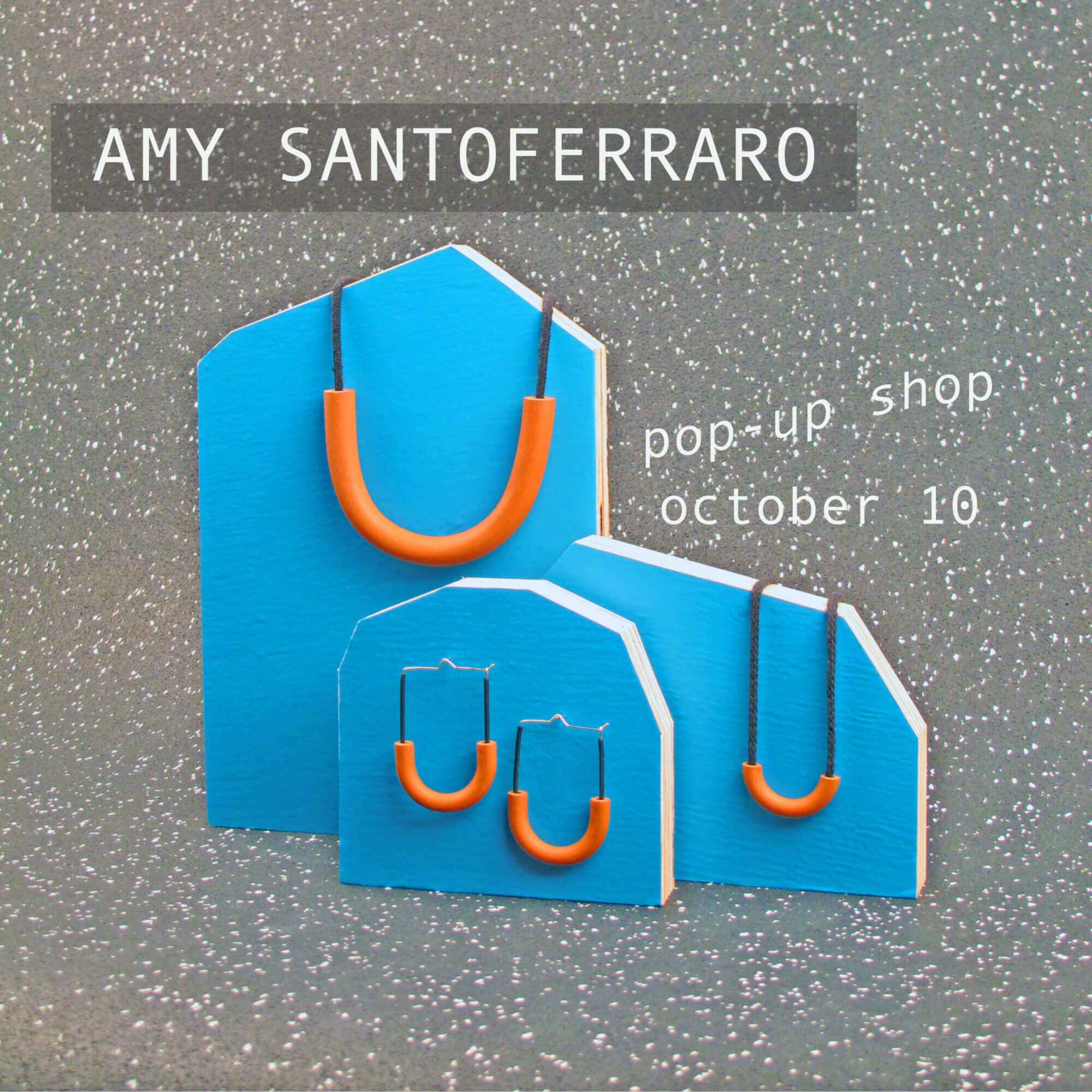Hey Ceramophiles! I am honored to introduce this week’s Pop-Up Shop resident Amy Santoferraro. At NCECA 2017, I purchased one of her ceramic macaroni necklaces. Its definitely my favorite object to wear. That glorious burnt orange matches everything, not to mention the shape is undeniably uplifting, and that is probably because its like wearing a giant smile around your neck. I find passers by cannot resist reaching for it. You absolutely must touch these smooth earthenware macaronis.
Santoferraro is the Program Manager of the Applied Craft and Design MFA program shared by Oregon College of Art and Craft and the Pacific Northwest College of Art, in Portland, Oregon.
I got the chance to ask her some questions about her collections and her art practice.
CFiIe: I want to talk about the work you make that isn’t jewelry. How did you get started with ceramics?
Amy: I studied to be an optometrist, and took a ceramics class in an attempt to relax and have some fun while toiling over repeated math failures. My ceramics/ceramic art history instructors and peers at The Ohio State University in Columbus, Ohio were all amazing, brilliant and kind people. I liked being around, they liked having me around, so I stuck around. The vessel was my first entry into ceramics. I fell in love with the idea of creating a useful object that had a built-in guideline: if it holds water and you can drink out of it, you have succeeded! The cup remains present in my practice as a way to get the work out of the studio and into hands. I always make a “take away” or a smaller more practical, more attainable object that represents the larger work but can fit in your hand and won’t break your wallet or back. Macaroni Jewelry is the most recent iteration that follows this logic.
CFile: Sounds like you have a lot of objects. Are they all on display in your studio? How do you store them?
Amy: I was once described as living a seamless life, but it felt more like an accusation of not having the ability to separate art and life. I get it now, having recently packed up my home and studio of 5 years paired with a new desire to live abroad I made a drastic decision. I WILL NOT BUY ANY OBJECTS FOR AT LEAST ONE YEAR! So naturally when a constraint is placed, a new collection begins! Without the ability to purchase objects I am limiting myself to taking on objects that I find (free and foraged), and within that I am limiting myself to the square as an added constraint. Sure, I’m interested in thinking about how most of our lives are currently represented in square format because of instagram, but I am more interested in butting up against something in the effort to reveal or learn something about the manner in which we filter objects into our lives. My momentary constrained collecting, is also an exercise influenced by reading Life A User’s Manual a constrained novel by George Perec.
CFile: Tell about the first collection you remember making? Or a recent collection that you have been working on?
Amy: The first collection I made was about science,magic,protection and make- believing until you believe-believe! The story of my first collection was my entry into making and is outlined in beginning of my artist statement:
As a kid I secretly collected “shoe poison”. I kept records of each pair of shoes that helped contribute to my coveted collection of gel silica. Diagrams, dates of purchase, sizes, colors, and materials were all meticulously catalogued in my Holly Hobby notebook. Only my Best Friends were invited to my top-secret laboratory/closet to view it and hear of my somewhat sinister plans to poison bad guys.
I’ve taken a break from collecting (If you keep saying it, it it must be true right?) and have been looking at my studio practice/supply closet as the only collection worth building… for the time being. The hunt is what’s most attractive to me about any collection. Polyester fabric in obnoxious prints is the current material of my affection. I’m enjoying the physical flexibility granted by this material paired with the harsh sentimental reconciliation of combining it with prints and objects of my “generation” in both senses of the word.

Model wears Small Macaroni Necklace. Click to shop!
Amy: It’s a really good and oddly versatile/ubiquitous shape! For most of us macaroni was the first material we used to make a necklace, usually for our Moms but sometimes for ourselves, just for fun or to pass the time. I hope the macaroni jewelry I make operates as an elegant but casual reminder of the adaptability and possibility we see in objects as children. It’s a piece of jewelry but it’s also a smile or a horseshoe. Wearing a smile and a horseshoe can help you make more smiles and catch all the good luck!



Add your valued opinion to this post.